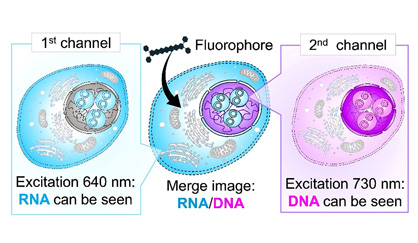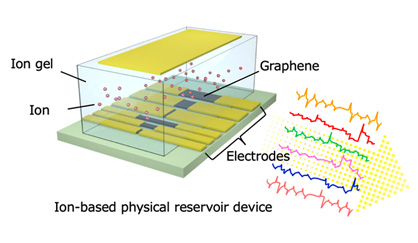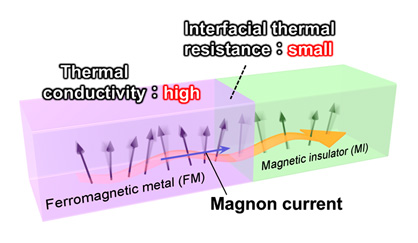Data Science Approach to Identifying Thermal Conductivity-Related Structural Factors in Amorphous Materials
—A Breakthrough in Metastable Materials Research—2024.01.19
NIMS (National Institute for Materials Science)
Tohoku University
Using data science techniques, a NIMS–Tohoku University research team has discovered that different thermal conductivities exhibited by an amorphous material with the same composition are attributable to the sizes of atomic rings in its atomic structure.
Abstract
- Using data science techniques, a NIMS–Tohoku University research team has discovered that different thermal conductivities exhibited by an amorphous material with the same composition are attributable to the sizes of atomic rings in its atomic structure. This is one of the first studies demonstrating that the structural features of amorphous materials can be correlated with their physical properties.
- It is already feasible to synthesize amorphous materials with the same compositions but different thermal conductivities. However, the structural factors responsible for differences in thermal conductivity had yet to be identified due to a lack of appropriate analytical methods.
- It had been impossible to identify structural differences between amorphous germanium (Ge) materials with different thermal conductivities based only on high-resolution transmission electron microscope (TEM) observation. This research team analyzed amorphous Ge material TEM images using data science techniques—topological data analysis and principal component analysis—and identified structural differences between the materials. The team found that the atomic structures of thin film specimens deposited at lower temperatures tended to be dominated by smaller atomic rings (Ge25) while specimens deposited at higher temperatures contained higher proportions of larger atomic rings (Ge300).
- Larger atomic rings had been shown theoretically to be associated with higher thermal conductivity. This study found that Ge300 had higher thermal conductivity than Ge25—results consistent with the theoretical evidence.
- The data science techniques developed in this research project can be used to identify metastable phases in materials—a task impossible to achieve using conventional structural analysis techniques. These techniques are therefore expected to be useful in developing metastable phase-integrated thermal control materials. They may also be useful in identifying structural features associated with the mechanical, electrical and other properties of amorphous materials in addition to their thermal properties.
- This research was carried out by a research team consisting of Yibin Xu (Leader, Data-driven Inorganic Materials Group, Center for Basic Research on Materials, NIMS) and Kazuto Akagi (Associate Professor, Advanced Institute for Materials Research, Tohoku University). This work was conducted as part of a JST CREST Exploring Unknown Materials project (research supervisor: Professor Hiroshi Kitagawa, grant number: PMJCR21O2). It was also funded by JSPS Grant-in-Aid for Transformative Research (A) (project number: 22H05109) and Scientific Research (A) (project number: 20H00119).
- This research was published in the December 6, 2023 issue of the International Journal of Heat and Mass Transfer (vol. 221).

Figure. Distribution of atomic rings extracted from TEM images: Distribution of atomic rings extracted from TEM images: Smaller (red dots) atomic rings are dominant in Ge25 while Ge300 contains a higher proportion of larger (blue dots) atomic rings.
Published Paper
(”Topological data analysis of TEM-based structural features affecting the thermal conductivity of amorphous Ge” Yen-Ju Wu, Kazuto Akagi, Masahiro Goto, Yibin Xu; Journal: International Journal of Heat and Mass Transfer [December 6, 2023]; DOI : 10.1016/j.ijheatmasstransfer.2023.125012)
Contact information
(Regarding this research)
Xu Yibin
Group Leader
Data-driven Inorganic Materials Group
Data-driven Materials Research Field
Center for Basic Research on Materials, NIMS
Group Leader
Data-driven Inorganic Materials Group
Data-driven Materials Research Field
Center for Basic Research on Materials, NIMS
TEL: +81-29-859-2258
Email: XU.Yibin=nims.go.jp (Please change "=" to "@")
Email: XU.Yibin=nims.go.jp (Please change "=" to "@")
Kazuto Akagi
Associate Professor
Mathematical Science Group
Advanced Institute for Materials Research (AIMR), Tohoku University
Associate Professor
Mathematical Science Group
Advanced Institute for Materials Research (AIMR), Tohoku University
Email: kazuto.akagi.b5=tohoku.ac.jp (Please change "=" to "@")
(General information)
Public Relations Office, NIMS
TEL: +81-29-859-2026
FAX: +81-29-859-2017
E-Mail: pressrelease=ml.nims.go.jp (Please change "=" to "@")
FAX: +81-29-859-2017
E-Mail: pressrelease=ml.nims.go.jp (Please change "=" to "@")
Strategic Public Relations Office
Advanced Institute for Materials Research (AIMR), Tohoku University
2-1-1 Katahira, Aoba-ku, Sendai,
980-8577 Japan
Advanced Institute for Materials Research (AIMR), Tohoku University
2-1-1 Katahira, Aoba-ku, Sendai,
980-8577 Japan
TEL: +81-22-217-6146
FAX: +81-22-217-5129
E-Mail: aimr-outreach=grp.tohoku.ac.jp (Please change "=" to "@")
FAX: +81-22-217-5129
E-Mail: aimr-outreach=grp.tohoku.ac.jp (Please change "=" to "@")
(Inquiries regarding JST research funding programs)
Public Relations Division
Department of General Affairs
Japan Science and Technology Agency
5-3 Yonbancho, Chiyoda-ku, Tokyo,
102-8666, Japan
Department of General Affairs
Japan Science and Technology Agency
5-3 Yonbancho, Chiyoda-ku, Tokyo,
102-8666, Japan
FAX: +81-3-5214-8432
E-Mail: jstkoho=jst.go.jp
E-Mail: jstkoho=jst.go.jp



